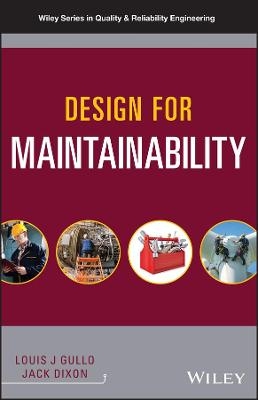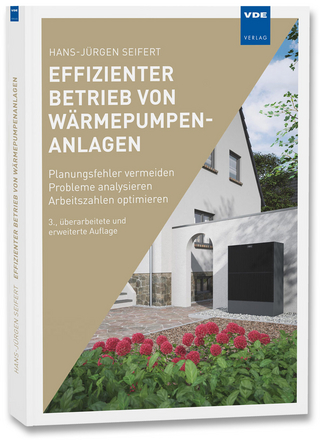
Design for Maintainability
John Wiley & Sons Inc (Verlag)
978-1-119-57851-2 (ISBN)
Design for Maintainability offers engineers a wide range of tools and techniques for incorporating maintainability into the design process for complex systems. With contributions from noted experts on the topic, the book explains how to design for optimum maintenance capabilities while simultaneously minimizing the time to repair equipment.
The book contains a wealth of examples and the most up-to-date maintainability design practices that have proven to result in better system readiness, shorter downtimes, and substantial cost savings over the entire system life cycle, thereby, decreasing the Total Cost of Ownership. Design for Maintainability offers a wealth of design practices not covered in typical engineering books, thus allowing readers to think outside the box when developing maintainability design requirements. The book�s principles and practices can help engineers to dramatically improve their ability to compete in global markets and gain widespread customer satisfaction. This important book:
Offers a complete overview of maintainability engineering as a system engineering discipline
Includes contributions from authors who are recognized leaders in the field
Contains real-life design examples, both good and bad, from various industries
Presents realistic illustrations of good maintainability design principles
Provides discussion of the interrelationships between maintainability with other related disciplines
Explores trending topics in technologies Written for design and logistics engineers and managers, Design for Maintainability is a comprehensive resource containing the most reliable and innovative techniques for improving maintainability when designing a system or product.
Louis J. Gullo, Electrical Engineer with over 35 years of leadership and hands-on experience in electronic systems, advanced technology research, reliability requirements, and engineering hardware and software development. Louis is retired from the US Army and Raytheon, an IEEE Senior Member, IEEE Reliability Society Standards Committee chair, currently employed at Northrop Grumman Corporation (NGC), Roy, UT. He is the co-editor/author of Design for Reliability and Design for Safety, both from Wiley. Jack Dixon is a Systems Engineering Consultant and President of JAMAR International, Inc. He has worked in the defense industry for over forty years doing system safety, human factors engineering, logistics support, systems engineering, program management, and business development. He is a contributing author of Design for Reliability and the co-author Design for Safety, both from Wiley.
Series Editor’s Foreword by Dr Andre Kleyner xix
Preface xxi
Acknowledgments xxiii
Introduction: What You Will Learn xxv
1 Design for Maintainability Paradigms 1
Louis J. Gullo and Jack Dixon
1.1 Why Design for Maintainability? 1
1.1.1 What is a System? 1
1.1.2 What is Maintainability? 1
1.1.3 What is Testability? 2
1.2 Maintainability Factors for Design Consideration 2
1.2.1 Part Standardization 3
1.2.2 Structure Modularization 3
1.2.3 Kit Packaging 3
1.2.4 Part Interchangeability 3
1.2.5 Human Accessibility 4
1.2.6 Fault Detection 4
1.2.7 Fault Isolation 4
1.2.8 Part Identification 5
1.3 Reflections on the Current State of the Art 5
1.4 Paradigms for Design for Maintainability 6
1.4.1 Maintainability is Inversely Proportional to Reliability 7
1.4.2 Maintainability is Directly Proportional to Testability and Prognostics and Health Monitoring 7
1.4.3 Strive for Ambiguity Groups No Greater Than 3 7
1.4.4 Migrate from Scheduled Maintenance to Condition-based Maintenance 8
1.4.5 Consider the Human as the Maintainer 8
1.4.6 Modularity Speeds Repairs 8
1.4.7 Maintainability Predicts Downtime During Repairs 8
1.4.8 Understand the Maintenance Requirements 9
1.4.9 Support Maintainability with Data 9
1.5 Summary 10
References 11
2 History of Maintainability 13
Louis J. Gullo
2.1 Introduction 13
2.2 Ancient History 13
2.3 The Difference Between Maintainability and Maintenance Engineering 14
2.4 Early Maintainability References 15
2.4.1 The First Maintainability Standards 15
2.4.2 Introduction to MIL-STD-470 16
2.5 Original Maintainability Program Roadmap 17
2.5.1 Task 1: The Maintainability Program Plan 17
2.5.2 Task 2: Maintainability Analysis 17
2.5.3 Task 3: Maintenance Inputs 18
2.5.4 Task 4: Maintainability Design Criteria 18
2.5.5 Task 5: Maintainability Trade Studies 19
2.5.6 Task 6: Maintainability Predictions 19
2.5.7 Task 7: Vendor Controls 19
2.5.8 Task 8: Integration 19
2.5.9 Task 9: Maintainability Design Reviews 20
2.5.10 Task 10: Maintainability Data System 21
2.5.11 Task 11: Maintainability Demonstration 21
2.5.12 Task 12: Maintainability Status Reports 21
2.6 Maintainability Evolution Over the Time Period 1966 to 1978 21
2.7 Improvements During the Period 1978 to 1997 22
2.8 Introduction of Testability 23
2.9 Introduction of Artificial Intelligence 24
2.10 Introduction to MIL-HDBK-470A 24
2.11 Summary 26
References 26
3 Maintainability Program Planning and Management 29
David E. Franck, CPL and Anne Meixner, PhD
3.1 Introduction 29
3.2 System/Product Life Cycle 29
3.3 Opportunities to Influence Design 33
3.3.1 Engineering Design 33
3.3.2 Design Activities 33
3.3.3 Design Reviews 36
3.4 Maintainability Program Planning 37
3.4.1 Typical Maintainability Engineering Tasks 38
3.4.2 Typical Maintainability Program Plan Outline 38
3.5 Interfaces with Other Functions 42
3.6 Managing Vendor/Subcontractor Maintainability Efforts 44
3.7 Change Management 45
3.8 Cost-effectiveness 47
3.9 Maintenance and Life Cycle Cost (LCC) 50
3.10 Warranties 52
3.11 Summary 53
References 54
Suggestions for Additional Reading 54
4 Maintenance Concept 55
David E. Franck, CPL
4.1 Introduction 55
4.2 Developing the Maintenance Concept 57
4.2.1 Maintainability Requirements 60
4.2.2 Categories of Maintenance 61
4.2.2.1 Scheduled Maintenance 61
4.2.2.2 Unscheduled Maintenance 63
4.3 Levels of Maintenance 69
4.4 Logistic Support 70
4.4.1 Design Interface 71
4.4.2 Design Considerations for Improved Logistics Support 71
4.4.2.1 Tools 71
4.4.2.2 Skills 72
4.4.2.3 Test/Support Equipment – Common and Special 72
4.4.2.4 Training 72
4.4.2.5 Facilities 73
4.4.2.6 Reliability 73
4.4.2.7 Spares Provisioning 75
4.4.2.8 Backshop Support 75
4.5 Summary 76
References 77
Suggestions for Additional Reading 77
5 Maintainability Requirements and Design Criteria 79
Louis J. Gullo and Jack Dixon
5.1 Introduction 79
5.2 Maintainability Requirements 79
5.2.1 Different Maintainability Requirements for Different Markets 81
5.3 The Systems Engineering Approach 81
5.3.1 Requirements Analysis 82
5.3.1.1 Types of Requirements 82
5.3.1.2 Good Requirements 83
5.3.2 System Design Evaluation 84
5.3.3 Maintainability in the Systems Engineering Process 84
5.4 Developing Maintainability Requirements 84
5.4.1 Defining Quantitative Maintainability Requirements 85
5.4.2 Quantitative Preventive Maintainability Requirements 87
5.4.3 Quantitative Corrective Maintainability Requirements 88
5.4.4 Defining Qualitative Maintainability Requirements 90
5.5 Maintainability Design Goals 90
5.6 Maintainability Guidelines 91
5.7 Maintainability Design Criteria 91
5.8 Maintainability Design Checklists 93
5.9 Design Criteria that Provide or Improve Maintainability 94
5.10 Conclusions 95
References 95
Suggestions for Additional Reading 96
Additional Sources of Checklists 96
6 Maintainability Analysis and Modeling 97
James Kovacevic
6.1 Introduction 97
6.2 Functional Analysis 98
6.2.1 Constructing a Functional Block Diagram 99
6.2.2 Using a Functional Block Diagram 100
6.3 Maintainability Analysis 100
6.3.1 Objectives of Maintainability Analyses 101
6.3.2 Typical Products of Maintainability Analyses 101
6.4 Commonly Used Maintainability Analyses 101
6.4.1 Equipment Downtime Analysis 102
6.4.2 Maintainability Design Evaluation 102
6.4.3 Testability Analysis 102
6.4.4 Human Factors Analysis 102
6.4.5 Maintainability Allocations 103
6.4.5.1 Failure Rate Complexity Method 104
6.4.5.2 Variation of the Failure Rate Complexity Method 104
6.4.5.3 Statistically-based Allocation Method 104
6.4.5.4 Equal Distribution Method 106
6.4.6 Maintainability Design Trade Study 106
6.4.7 Maintainability Models and Modeling 108
6.4.7.1 Poisson Distribution in Maintainability Models 108
6.4.8 Failure Modes, Effects, and Criticality Analysis – Maintenance Actions (FMECA-MA) 110
6.4.9 Maintenance Activities Block Diagrams 110
6.4.10 Maintainability Prediction 112
6.4.11 Maintenance Task Analysis (MTA) 112
6.4.12 Level of Repair Analysis (LORA) 113
6.4.12.1 Performing a Level of Repair Analysis 114
6.4.12.2 Managing LORA Data 116
6.4.12.3 Level of Repair Analysis Outcomes 117
6.5 Summary 117
References 117
Suggestion for Additional Reading 118
7 Maintainability Predictions and Task Analysis 119
Louis J. Gullo and James Kovacevic
7.1 Introduction 119
7.2 Maintainability Prediction Standard 119
7.3 Maintainability Prediction Techniques 120
7.3.1 Maintainability Prediction Procedure I 121
7.3.1.1 Preparation Activities 121
7.3.1.2 Failure Verification Activities 121
7.3.1.3 Failure Location Activities 122
7.3.1.4 Part Procurement Activities 122
7.3.1.5 Repair Activities 122
7.3.1.6 Final Test Activities 123
7.3.1.7 Probability Distributions 123
7.3.2 Maintainability Prediction Procedure II 123
7.3.2.1 Use of Maintainability Predictions for Corrective Maintenance 123
7.3.2.2 Use of Maintainability Predictions for Preventive Maintenance 124
7.3.2.3 Use of Maintainability Predictions for Active Maintenance 124
7.3.3 Maintainability Prediction Procedure III 124
7.3.4 Maintainability Prediction Procedure IV 125
7.3.5 Maintainability Prediction Procedure V 127
7.4 Maintainability Prediction Results 127
7.5 Bayesian Methodologies 129
7.5.1 Definition of Bayesian Terms 130
7.5.2 Bayesian Example 130
7.6 Maintenance Task Analysis 130
7.6.1 Maintenance Task Analysis Process andWorksheets 132
7.6.2 Completing a Maintenance Task Analysis Sheet 134
7.6.3 Personnel and Skill Data Entry 134
7.6.4 Spare Parts, Supply Chain, and Inventory Management Data Entry 135
7.6.5 Test and Support Equipment Data Entry 137
7.6.6 Facility Requirements Data Entry 137
7.6.7 Maintenance Manuals 138
7.6.8 Maintenance Plan 138
7.7 Summary 139
References 139
8 Design for Machine Learning 141
Louis J. Gullo
8.1 Introduction 141
8.2 Artificial Intelligence in Maintenance 142
8.3 Model-based Reasoning 144
8.3.1 Diagnosis 145
8.3.2 Health Monitoring 145
8.3.3 Prognostics 145
8.4 Machine Learning Process 145
8.4.1 Supervised and Unsupervised Learning 147
8.4.2 Deep Learning 148
8.4.3 Function Approximations 149
8.4.4 Pattern Determination 150
8.4.5 Machine Learning Classifiers 150
8.4.6 Feature Selection and Extraction 151
8.5 Anomaly Detection 152
8.5.1 Known and Unknown Anomalies 152
8.6 Value-added Benefits of ML 153
8.7 Digital Prescriptive Maintenance (DPM) 154
8.8 Future Opportunities 154
8.9 Summary 155
References 155
9 Condition-based Maintenance and Design for Reduced Staffing 157
Louis J. Gullo and James Kovacevic
9.1 Introduction 157
9.2 What is Condition-based Maintenance? 158
9.2.1 Types of Condition-based Maintenance 158
9.3 Condition-based Maintenance vs. Time-based Maintenance 159
9.3.1 Time-based Maintenance 159
9.3.2 Types of Time-based Maintenance 159
9.3.3 Calculating Time-based Maintenance Intervals 160
9.3.4 The P-F Curve 160
9.3.5 Calculating Condition-based Maintenance Intervals 162
9.4 Reduced Staffing Through CBM and Efficient TBM 163
9.5 Integrated System Health Management 164
9.6 Prognostics and CBM+ 165
9.6.1 Essential Elements of CBM+ 170
9.7 Digital Prescriptive Maintenance 170
9.8 Reliability-centered Maintenance 172
9.8.1 History of RCM 172
9.8.2 What is RCM? 173
9.8.3 Why RCM? 174
9.8.4 What we Learned from RCM 174
9.8.4.1 Failure Curves 175
9.8.5 Applying RCM in Your Organization 177
9.8.5.1 InnerWorkings of RCM 177
9.9 Conclusion 180
References 181
Suggestion for Additional Reading 181
10 Safety and Human Factors Considerations in Maintainable Design 183
Jack Dixon
10.1 Introduction 183
10.2 Safety in Maintainable Design 183
10.2.1 Safety and its Relationship to Maintainability 184
10.2.2 Safety Design Criteria 184
10.2.3 Overview of System Safety Engineering 187
10.2.4 Risk Assessment and Risk Management 187
10.2.4.1 Probability 188
10.2.4.2 Consequences 188
10.2.4.3 Risk Evaluation 189
10.2.5 System Safety Analysis 190
10.2.5.1 Operating and Support Hazard Analysis 191
10.2.5.2 Health Hazard Analysis 193
10.3 Human Factors in Maintainable Design 195
10.3.1 Human Factors Engineering and its Relationship to Maintainability 195
10.3.2 Human Systems Integration 196
10.3.3 Human Factors Design Criteria 196
10.3.4 Human Factors Engineering Analysis 198
10.3.5 Maintainability Anthropometric Analysis 199
10.4 Conclusion 205
References 206
Suggestion for Additional Reading 206
11 Design for Software Maintainability 207
Louis J. Gullo
11.1 Introduction 207
11.2 What is Software Maintainability? 208
11.3 Relevant Standards 208
11.4 Impact of Maintainability on Software Design 209
11.5 How to Design Software that is Fault-tolerant and Requires Zero Maintenance 210
11.6 How to Design Software that is Self-aware of its Need for Maintenance 212
11.7 How to Develop Maintainable Software that was Not Designed for Maintainability at the Start 213
11.8 Software Field Support and Maintenance 214
11.8.1 Software Maintenance Process Implementation 214
11.8.2 Software Problem Identification and Software Modification Analysis 215
11.8.3 Software Modification Implementation 215
11.8.4 Software Maintenance Review and Acceptance 215
11.8.5 Software Migration 215
11.8.6 Software Retirement 215
11.8.7 Software Maintenance Maturity Model 216
11.9 Software Changes and Configuration Management 216
11.10 Software Testing 217
11.11 Summary 218
References 218
12 Maintainability Testing and Demonstration 221
David E. Franck, CPL
12.1 Introduction 221
12.2 When to Test 222
12.3 Forms of Testing 224
12.3.1 Process Reviews 225
12.3.2 Modeling or Simulation 225
12.3.3 Analysis of the Design 227
12.3.4 In-process Testing 227
12.3.5 Formal Design Reviews 228
12.3.6 Maintainability Demonstration (M-Demo) 228
12.3.6.1 M-Demo Test Plan 229
12.3.6.2 M-Demo Maintenance Task Sample Selection 230
12.3.6.3 M-Demo Test Report 233
12.3.6.4 AN/UGC-144 M-Demo Example 234
12.3.7 Operational Maintainability Testing 236
12.4 Data Collection 236
12.5 Summary 241
References 242
Suggestions for Additional Reading 243
13 Design for Test and Testability 245
Anne Meixner and Louis J. Gullo
13.1 Introduction 245
13.2 What is Testability? 245
13.3 DfT Considerations for Electronic Test at All Levels 247
13.3.1 What is Electronic Test? 247
13.3.2 Test Coverage and Effectiveness 248
13.3.3 Accessibility Design Criteria Related to Testability 249
13.4 DfT at System or Product Level 250
13.4.1 Power-On Self-Test and On-Line Testing 251
13.5 DfT at Electronic Circuit Board Level 251
13.6 DfT at Electronic Component Level 253
13.6.1 System in Package/Multi-chip Package Test and DfT Techniques 253
13.6.2 VLSI and DfT Techniques 255
13.6.3 Logic Test and Design For Test 255
13.6.4 Memory Test and Design for Test 256
13.6.5 Analog and Mixed-Signal Test and DfT 259
13.6.6 Design and Test Tradeoffs 260
13.7 Leveraging DfT for Maintainability and Sustainment 261
13.7.1 Built-In-Test/Built-In Self-Test 261
13.8 BITE and External Support Equipment 262
13.9 Summary 262
References 262
Suggestions for Additional Reading 263
14 Reliability Analyses 265
Jack Dixon
14.1 Introduction 265
14.2 Reliability Analysis and Modeling 266
14.3 Reliability Block Diagrams 266
14.4 Reliability Allocation 268
14.5 Reliability Mathematical Model 269
14.6 Reliability Prediction 269
14.7 Fault Tree Analysis 270
14.7.1 What is a Fault Tree? 270
14.7.2 Gates and Events 271
14.7.3 Definitions 271
14.7.4 Methodology 271
14.7.5 Cut Sets 273
14.7.6 Quantitative Analysis of Fault Trees 276
14.7.7 Advantages and Disadvantages 276
14.8 Failure Modes, Effects, and Criticality Analysis 276
14.9 Complementary Reliability Analyses and Models 279
14.10 Conclusions 279
References 280
Suggestions for Additional Reading 280
15 Design for Availability 281
James Kovacevic
15.1 Introduction 281
15.2 What is Availability? 281
15.3 Concepts of Availability 283
15.3.1 Elements of Availability 285
15.3.1.1 Time-related Elements 286
15.3.1.2 Mean Metrics 287
15.4 Types of Availability 289
15.4.1 Inherent Availability 289
15.4.2 Achieved Availability 290
15.4.3 Operational Availability 291
15.4.3.1 Ao Method 1 291
15.4.3.2 Ao Method 2 292
15.4.3.3 Ao Method 3 292
15.4.3.4 Ao Method 4 293
15.5 Availability Prediction 294
15.5.1 Data for Availability Prediction 295
15.5.2 Calculating Availability 296
15.5.3 Steps to Availability Prediction 298
15.5.3.1 Define the Problem 299
15.5.3.2 Define the System 299
15.5.3.3 Collect the Data 299
15.5.3.4 Build the Model 299
15.5.3.5 Verify the Model 299
15.5.3.6 Design the Simulation 299
15.5.3.7 Run the Simulation 300
15.5.3.8 Document and Use the Results 300
15.6 Conclusion 300
References 301
16 Design for Supportability 303
James Kovacevic
16.1 Introduction 303
16.2 Elements of Supportability 304
16.2.1 Product Support Management 305
16.2.2 Design Interface 306
16.2.3 Sustaining Engineering 307
16.2.4 Supply Support 308
16.2.5 Maintenance Planning and Management 309
16.2.6 Packaging, Handling, Storage, and Transportation (PHS&T) 311
16.2.7 Technical Data 312
16.2.8 Support Equipment 315
16.2.9 Training and Training Support 315
16.2.10 Manpower and Personnel 316
16.2.11 Facilities and Infrastructure 317
16.2.12 Computer Resources 318
16.3 Supportability Program Planning 319
16.3.1 Supportability Analysis 319
16.4 Supportability Tasks and the ILS Plan 321
16.5 Summary 322
References 322
Suggestion for Additional Reading 322
17 Special Topics 323
Jack Dixon
17.1 Introduction 323
17.2 Reducing Active Maintenance Time with Single Minute Exchange of Dies (SMED) 323
17.2.1 Incorporating Lean Methods into PM Optimization 325
17.2.1.1 UnderstandingWaste 325
17.2.1.2 Apply Lean Techniques to EliminateWaste 326
17.2.1.3 Continually Improve the PM Routine 329
17.2.2 Summary 330
17.3 How to use Big Data to Enable Predictive Maintenance 330
17.3.1 Industry Use 331
17.3.2 Predicting the Future 332
17.3.3 Summary 333
17.4 Self-correcting Circuits and Self-healing Materials for Improved Maintainability, Reliability, and Safety 334
17.4.1 Self-correcting Circuits 334
17.4.2 Self-healing Materials 335
17.4.3 Summary 336
17.5 Conclusion and Challenge 337
References 337
Suggestions for Additional Reading 338
Appendix A System Maintainability Design Verification Checklist 339
A.1 Introduction 339
A.2 Checklist Structure 339
Index 353
| Erscheinungsdatum | 19.03.2021 |
|---|---|
| Reihe/Serie | Quality and Reliability Engineering Series |
| Verlagsort | New York |
| Sprache | englisch |
| Maße | 170 x 244 mm |
| Gewicht | 1077 g |
| Themenwelt | Technik ► Elektrotechnik / Energietechnik |
| Technik ► Nachrichtentechnik | |
| ISBN-10 | 1-119-57851-5 / 1119578515 |
| ISBN-13 | 978-1-119-57851-2 / 9781119578512 |
| Zustand | Neuware |
| Informationen gemäß Produktsicherheitsverordnung (GPSR) | |
| Haben Sie eine Frage zum Produkt? |
aus dem Bereich


